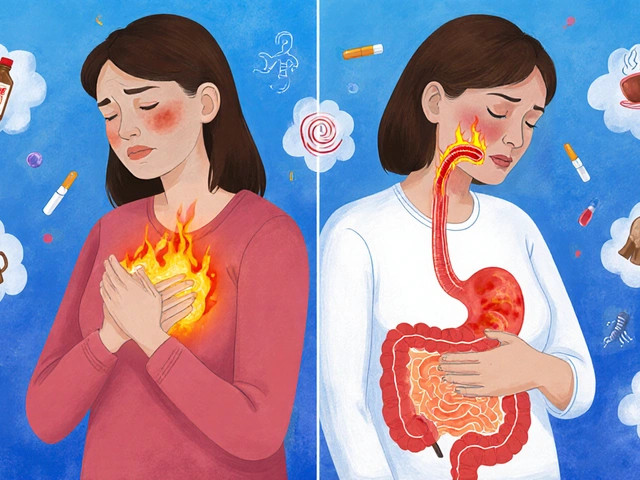If you’ve ever walked outside for just a few minutes and your cheeks start burning like you spent hours at the beach, you’re not imagining it. Rosacea skin has a sneaky way of feeling sunburned at the slightest trigger—including when there’s barely any sun. I’ve had days where a quick phone call outside leaves my face tingling and flushed. It’s not just annoying; that stinging, burning pain feels unfair, especially if you slathered on SPF or stayed in the shade. Digging into the science behind why rosacea burns almost like a sunburn opens up a whole new layer of understanding—not just what’s happening under your skin, but what you can actually do to stop the burn in its tracks.
What Makes Rosacea Skin Burn Like a Sunburn?
There’s this cliché about rosacea just being a “red face” or a makeup hassle, but that's missing the real problem: the burning, stinging, and heat that can show up at any time. Want to know what’s intense? Doctors see rosacea skin react to mild weather like someone else’s skin would react to a blowtorch. This is because people with rosacea have incredibly sensitive neurovascular systems in their skin. Your body’s nervous and vascular (blood vessel) systems get tangled together, literally and figuratively, right beneath your skin’s surface. When you have rosacea, your tiny facial blood vessels (called capillaries) are super-reactive. Think of them as car alarms set to go off at the tiniest nudge. Heat, sunlight, spicy food, embarrassment—even getting nervous before a big meeting—can send those vessels into overdrive.
Here’s where it gets interesting. With rosacea, the nerve endings around your blood vessels get a little too chatty, constantly firing off signals. Scientists call this “neurogenic inflammation.” What does it mean? It’s not just swelling or redness; it’s nerves releasing chemicals like substance P and calcitonin gene-related peptide (CGRP). These messengers tell blood vessels to dilate (so you flush red), make the skin leaky (hello puffiness), and stir up immune cells so you end up with that classic burning sensation. All of this happens fast, which is why a rosacea flare can peak in minutes—even if nothing dramatic triggered it.
Let’s compare what actually happens in your skin layer by layer. In healthy skin, the blood vessels can expand or contract without drama, controlled by your body’s natural balancing act. In rosacea, the vessels basically have performance anxiety—they overreact, get inflamed, and stay inflamed longer. And, to add to the misery, your skin’s protective barrier (the thing that keeps irritants out and moisture in) breaks down. Instead of repelling heat, spicy food, or wind, it absorbs irritation right down to those jumpy nerve endings. That’s why even a gentle facecloth can feel like sandpaper on a bad rosacea day.
There’s good proof of these nerve-blood vessel shenanigans too. Thermal imaging studies at major dermatology clinics have shown that, when you expose someone with rosacea to a little heat, the blood flow to their skin jumps much higher and much faster than in non-rosacea volunteers. Put simply: If you’ve got rosacea, your skin’s thermostat is broken—and stuck on HOT. No wonder you get that sunburn feeling even in winter.
Roles of Triggers and How Neurovascular Inflammation Gets Out of Control
This isn’t just about temperature. The list of rosacea triggers is like the world’s worst dinner menu: sunlight, alcohol, spicy food, wind, stress, hot drinks. What’s the common link? Everything that can irritate your sensory nerves or dilate your blood vessels. Even bright lights or certain makeup ingredients can set off that inner alarm system. A team at the University of California once mapped out triggers for rosacea patients and found that 81% mentioned weather, 79% blamed emotional stress, and 75% said hot baths or beverages brought on the burn.
Think about your own roadmap of redness. Maybe a glass of red wine at dinner is the main villain. Or maybe it’s just running from the car to the grocery store in winter. The real problem lies in how your body’s nerves and blood vessels react to these small “insults.” And it’s not just redness—it’s that distinctive burning pain. The term for this pain is “cutaneous hyperesthesia” and it often goes hand in hand with neurogenic inflammation. Nerve fibers become hypersensitive, firing off signals at the wrong times and telling your brain, “This is HOT and PAINFUL!” even when it really shouldn’t be.
Why do some people get stuck in this cycle? Part of it’s genetics. You might have inherited skin that’s more easily triggered. Another factor is repeated triggers. If you don’t break the cycle (by protecting your skin or avoiding triggers), the skin barrier keeps getting weaker, so the nerves and blood vessels get even more irritable. In fact, dermatologists see a feedback loop: the longer you go without managing your triggers, the more frequent and severe your burning flares become.
Ever noticed stronger stinging sensations as you age or after using harsh cleansers? That fits the model. The more the neurovascular inflammation happens, the more sensitive you’ll get to small irritants. At a microscopic level, immune cells called mast cells release even more of those stinging chemicals into your skin whenever a trigger hits. The experts describing this effect often mention the snowball effect—what starts as mild flushing can end up as a daily battle with burning pain.
It’s not just theoretical. There’s a fascinating chart that sums up the flare frequency among rosacea patients:
| Common Trigger | Percentage of Patients Triggered |
|---|---|
| Sunlight | 81% |
| Emotional Stress | 79% |
| Hot Weather | 75% |
| Wind | 57% |
| Hot Drinks | 54% |
| Spicy Foods | 45% |
This makes it easy to see how rosacea is not just a skin problem; it's a perfect storm of triggers piling on a system already ready to explode.

What the Science Says: Why the Burn Feels So Different
The biggest question I had when my burning flareups were at their worst wasn’t just “why me?” It was “why does this feel so much more intense than a regular sunburn?” Turns out, there are clear reasons. The nerves involved in rosacea pain aren’t just the surface pain receptors—they’re tied directly into systems that regulate heat, cold, pain, and blood flow. When a flare hits, these nerves release stuff like substance P (try saying that three times fast), CGRP, and other peptides. This isn’t just fancy medical talk—these are the same culprits that make bug bites itch and chili peppers burn your mouth.
In rosacea, these signals aren’t turned off when the trigger goes away. Blood vessels dilate and stay open, nerves keep tossing out inflammatory chemicals, and your immune system basically stages a sit-in. Even when your face cools off, the bacteria and chemical messengers lingering in the skin can keep things simmering. Studies from the National Rosacea Society talk about the “neurovascular flush”—how the chemical reaction continues long after the initial cause disappears. Think of it like an overzealous smoke detector that keeps blaring, even after you take the bread out of the toaster.
Another mind-blowing fact? People with rosacea have up to eight times as many blood vessels at the skin’s surface in the flushed areas compared to people without. More vessels mean more area for inflammation, more nerves to get irritable, and greater sensitivity to temperature swings. If you’ve ever noticed your whole face light up after just a few minutes in the sun or a hot kitchen, it’s because your skin literally has a higher “redness potential.”
A group of dermatologists in Scandinavia ran a study using capsaicin—the active ingredient in chili peppers—on the faces of people with and without rosacea. Those with rosacea felt intense stinging and burning within seconds, while the control group mostly just reported mild tingling. This backs up the idea of chemical hypersensitivity: the nerves in rosacea skin are not just sensitive, they’re hyper-reactive to otherwise mild triggers.
All this science does more than just explain the pain—it highlights why regular skin care tips don’t always work for rosacea. The neurovascular system just won’t calm down with a splash of cold water or aloe gel. You need something that addresses the inflammation at its root. This is why many dermatologists turn to specific medications, barrier-repair creams, and lifestyle changes, instead of just traditional sunburn remedies.
So, if you’ve tried every trick in the book—ice packs, green-tinted primers, and whatnot—and still feel the burn, it’s not your fault. It’s the nerve-blood vessel party happening right under your skin’s surface. Understanding this—the real reason for that sunburn feeling—gives you a fighting chance when choosing treatments and routines to finally put out those flames.
Smart Steps to Soothe and Prevent the Rosacea Burning
The struggle isn’t just about dousing a flare-up—you want to stop them before they start. The first rule? Do not mess with your skin’s protective barrier. Harsh scrubs, foaming cleansers, or even the wrong moisturizer can break down that crucial layer, leaving all those jumpy nerves exposed. Go for ultra-gentle, fragrance-free cleansers and heavier creams designed for sensitive or rosacea-prone skin. Think “slippery and bland” instead of “squeaky clean.” Ceramides, glycerin, and hyaluronic acid are your skin’s best friends here.
If you know your triggers—stress, heat, sunlight, spicy food—start tracking them in a journal. You’d be surprised how many patterns you’ll spot in a month. Sometimes, just swapping black tea for herbal or wearing a baseball cap outside makes a visible difference. And sunscreen? It’s non-negotiable. Mineral (zinc or titanium) sunscreens work better for rosacea, because chemical filters can irritate those overactive nerves. Look for SPF 30+ labeled “for sensitive skin” and make it a daily habit, even in winter or indoors if you sit near a window.
Another big weapon? Cool packs, not ice, on the skin when burning hits. Direct ice can actually shock rosacea-prone skin and make things worse. A washcloth soaked in cold water and wrung out will calm things down fast. If your skin can handle it, green tea compresses reduce inflammation for some people. Over-the-counter creams with niacinamide (vitamin B3) or allantoin can also help by supporting your skin’s ability to repair itself.
Medications might be necessary for stubborn cases. Dermatologists often prescribe topical metronidazole, azelaic acid, or ivermectin—these reduce inflammation at the neurovascular level and slow down the vicious cycle. Brimonidine is a gel that can shrink blood vessels for a few hours, great for big events when you really want to avoid the burn. Oral options (think doxycycline) are sometimes on the table if topical stuff doesn’t cut it. And don’t forget physical treatments: pulsed dye lasers can close off overactive blood vessels and actually lower the amount of “fuel” for future flares.
Extra tip from my own trial and error: Humidifiers aren’t just for dry winters—they relieve burning by preventing the air from pulling moisture out of your skin. I also swear by keeping a travel-size water mist spray in my bag. When I sense the burn coming, a quick spritz calms things fast without making me look shiny.
People get creative, too. I’ve heard of friends keeping their moisturizer in the fridge, using chamomile tea bags (cooled) over their cheeks, and even wearing UPF-rated clothing on sunny walks. Steven, my spouse, started bringing up how even warm showers could set off my skin, and now I finish with a 30-second blast of cool (not cold!) water on my face. Little changes like these add up fast.
There are loads more personal stories, tips, and science-backed advice at the sunburn rosacea guide, which I found seriously helpful when my symptoms flared at random. The bottom line? The burning from rosacea is real, it’s painful, and it has clear science behind it. You don’t have to just tough it out—understanding your triggers, your skin’s nerves, and how to build up that broken barrier can make all the difference when you feel like your face is on fire. And finding your own practical routine, with some patience and maybe a few cold compresses, is totally worth it.






Navin Kumar Ramalingam
May 25, 2025 AT 13:50Look, I get it - rosacea isn’t just ‘red face’ syndrome. But honestly, if your skin can’t handle a 70-degree day without screaming, maybe you’re over-indexing on environmental triggers and under-indexing on lifestyle. I’ve seen people in Delhi with zero AC and zero sunscreen, and their skin’s calmer than mine after a 10-minute walk to the mailbox. It’s not all neurovascular chaos - sometimes it’s just chronic overprotection turning skin into a greenhouse.
Also, ‘neurogenic inflammation’? That’s just fancy jargon for ‘your nerves are drama queens.’
Shawn Baumgartner
May 25, 2025 AT 15:23Let’s be real - this whole ‘neurovascular flush’ narrative is just Big Dermatology’s way of selling you $200 creams and laser treatments. The real issue? Your skin’s been chemically neutered by decades of over-cleansing, synthetic fragrances, and SPF obsession. You’ve stripped your epidermis down to a raw nerve ending and now you’re surprised it screams when you breathe too hard?
Meanwhile, in 1985, people didn’t even know what ‘rosacea’ was - they just washed their faces with soap and water and went about their day. The ‘burn’ isn’t science - it’s guilt. You’re being punished for caring too much.
Also, ‘brimonidine gel’? That’s vasoconstrictor abuse. You’re treating the symptom like it’s the disease. Classic medical capitalism.
Cassaundra Pettigrew
May 25, 2025 AT 22:43Oh, so now it’s ‘neurogenic inflammation’? Sounds like another woke medical buzzword to make white people feel special about their sensitive skin. You know what else burns? Being forced to sit through a 12-minute TikTok about your ‘skin journey’ while I’m trying to get to work.
Back in the day, we didn’t have ‘rosacea’ - we had ‘sunburn’ and we didn’t whine about it. We just wore hats. Or better yet - we didn’t live in climate-controlled glass boxes where your face thinks it’s in a sauna every time the AC kicks off.
And don’t get me started on ‘mineral sunscreen.’ That’s just zinc paste with a marketing team. You want relief? Stop being a delicate flower and go outside like a real American.
Brian O
May 26, 2025 AT 21:50I’ve had rosacea for 15 years and honestly? This post nailed it. The burning isn’t just redness - it’s like your face is holding a lit match under your skin. I used to think I was just ‘sensitive’ until I read about CGRP and substance P and realized - oh, my nerves are literally screaming at me.
What changed everything for me? Switching to a ceramide cream, ditching all fragranced products, and using a humidifier at night. Also, cold brew coffee instead of hot. I know it sounds dumb, but that one change cut my flares in half.
To anyone reading this: you’re not broken. Your skin just has a different operating system. It’s not about ‘toughening up’ - it’s about learning its language. And yes, the science is real. I’ve seen thermal images of my own face - the blood flow looks like a wildfire. It’s not in your head. You’re not weak. You’re just wired differently.
And if you’re tempted to try some ‘miracle cure’ from a guy on YouTube - don’t. Stick with dermatologist-backed stuff. It’s slow, but it works.
Steve Harvey
May 28, 2025 AT 12:59Wait - you think this is just about sun and stress? Nah. This is all connected. Big Pharma knows the truth: rosacea is a symptom of glyphosate poisoning. They’ve been spraying your food, your water, your damn air for 40 years. Your skin’s burning because your body is trying to purge the toxins - but the doctors? They’re too busy selling you $300 creams to ask why your neighbor’s kid has eczema, asthma, and now rosacea.
And don’t tell me ‘mineral sunscreen’ is safe. Zinc oxide? It’s nano-particles. They’re slipping into your bloodstream and messing with your mitochondria. I’ve seen the papers. It’s in the NIH archives if you know where to look.
Also, why do you think the FDA won’t ban parabens? Because they’re paid off. Same people who told us smoking was fine. Same people who said fluoride was harmless. Wake up. Your face is a warning system. Listen to it. Stop trusting the system.
And if you’re still using ‘niacinamide’ - you’re just feeding the machine. Try apple cider vinegar rinses. Or better yet - move to the mountains. No Wi-Fi. No processed food. No ‘dermatologists.’ Just dirt. Your skin will thank you.
Gary Katzen
May 28, 2025 AT 22:34Thanks for writing this. I’ve been too scared to say it out loud, but yeah - that burning? It’s not just me being dramatic. I used to feel guilty for avoiding parties because my face lit up like a Christmas tree when someone said ‘you look great!’
My dermatologist put me on azelaic acid. Took three months. Didn’t fix everything, but the ‘sunburn’ feeling? Cut by 70%. I still use a cold compress. Still avoid spicy food. Still wear a hat indoors when the lights are too bright.
You’re not alone. And you don’t have to ‘tough it out.’ Just find your rhythm. It’s not perfect. But it’s livable.
Also - thank you for mentioning humidifiers. I didn’t think anyone else knew about that one.
ryan smart
May 29, 2025 AT 22:05Just stop using so much crap on your face. Wash with water. Wear a hat. Done.